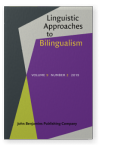Vol. 9:2 (2019) ► pp.163–201
How subject animacy constrains motion event descriptions
Evidence from sequential and simultaneous bilinguals in French and English
Research has indicated that during sentence processing, French native speakers predominantly rely upon lexico-semantic cues (i.e., animacy) while native speakers of English rely upon syntactic cues (i.e., word order). The present study examined sentence production in L1 French/L2 English and L1 English/L2 French sequential bilinguals. Participants used animate and inanimate entities as sentence subjects while describing motion events represented by static pictures. To test a gradual change in animacy cue weighting in second-language sequential bilinguals with different proficiency levels were included. Sentence production of sequential bilinguals was compared against that of simultaneous bilinguals. The results indicated an overall preference for the use of animate subjects for both languages at all proficiency levels. The effect of animacy was stronger for English L2 than French L2 while it did not differ between languages in simultaneous bilinguals. Evidence for potential change in the animacy-cue weighting was only observed for English L2.
Article outline
- 1.Introduction
- 2.Animacy, L2 and bilingualism
- 3.Motion events and animacy in bilinguals
- 4.Aim and design of the study
- 5.Method
- 5.1Participants
- 5.2Task
- 5.3Procedure
- 5.4Analysis
- 6.Results
- 6.1Quantitative analysis
- Sequential bilinguals
- Simultaneous bilinguals
- 6.2Qualitative analysis
- Sequential bilinguals
- Simultaneous bilinguals
- 6.1Quantitative analysis
- 7.Discussion
- 8.Conclusion
- Acknowledgements
-
References
